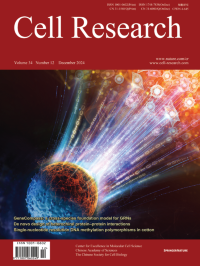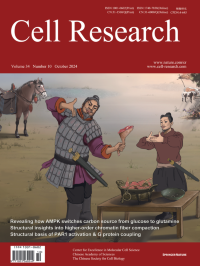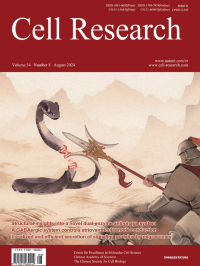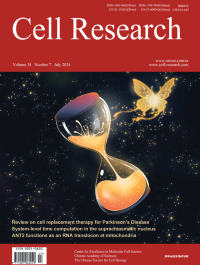Volume 34
-
No. 12 December 2024
This image depicts a story of a powerful AI comet merging in the life science universe. The information in millions of single-cell transcriptomes was distilled to create a large foundation model named GeneCompass, which uses cutting-edge foundation model AI technologies to decipher universal gene regulatory mechanisms and shows tremendous potential for accelerating advancements in life science research.See page 830–845 by Xiaodong Yang et al. for details.
-
No. 11 November 2024
Beneath the blazing sun, the guardian deity of agriculture wields the sacred sickle-shaped tool, TMS5, which removes cP from the cP-ΔCCA-tRNAs accumulated in rice, thereby safeguarding its fertility. In contrast, the rice left beyond his reach, burdened with cP-ΔCCA-tRNAs, remains sterile. See page 763–775 by Bin Yan et al. for details.
-
No. 10 October 2024
The image depicts a story that happened during the Warring States. A senior general named Lian Po, loyal to King of the Zhao State, was given a chunk of meat and became re-energized. The cover paper reports that the catabolism of the amino acid glutamine can replenish energy when glucose is depleted. See page 683–706 by Mengqi Li et al. for details.
-
No. 9 September 2024
The image depicts the Chinese legend "The Magic Brush" ("Shen Bi Ma Liang"). The towering mountain symbolizes the rugged protein fitness landscape, with reaching the summit representing the challenging tasks in protein engineering. Our proposed method, ProMEP, serves as the magic brush, sketching out a rapid path to the peak for biologists. The brush’s handle, adorned with dots, lines, and jewels, signifies the power of artificial intelligence technology driving this journey. See page 630–647 by Peng Cheng et al. for details.
-
No. 8 August 2024
The image depicts the legendary Chinese weapon ‘FangTian Ji’, a formidable combination of a spearhead and two crescent blades. This symbolizes the powerful bacterial two-component anti-phage defense system DUF4297–HerA. DUF4297 and HerA cooperatively assemble to activate their respective nuclease and ATPase activities, effectively eliminating invading phages. See page 545–555 by Qiyin An et al. for details.
-
No. 7 July 2024
The SCN is the central biological clock with thousands of twinking neurons as the time-keeping elements. At the system level, bilaterally symmetrical ripple-like patterns emerge from the functional organization of these neurons, aesthetically pleasing like that of a butterfly.
-
No. 6 June 2024
A Nian beast (proinflammatory PD-1+ T cells) wreaks havoc in the village (a metaphor for atherosclerosis, AS) on New Year's Eve. A man, dressed in red, ignites firecrackers (FcgR-binding anti-PD-1 mAb), preventing the Nian beast from causing trouble in the village (the shrinkage of AS plaques). See page 407–427 by Lin Fan et al. for details.
-
No. 5 May 2024
The image illustrates a Chinese historical story, depicting Taigong Jiang fishing with his hook, reminiscent of the innovative proximity labeling tool, PhastID. PhastID identifies ATP6AP1, an unconventional GEF of Rheb. The C-tail at the end of ATP6AP1 can be used as a switch for Rheb to regulate the activation of mTORC1 signaling. Just as the two different states of the fish in the image, activating Rheb or not has distinct impacts on cellular functions. See page 355–369 by Ran Feng et al. for details.
-
No. 4 April 2024
The cover image illustrates the aluminum (Al) ion receptor ALR1 (Beacon Tower)that senses toxic aluminum ions, inducing reactive oxygen species (ROS; smoke) generation and accumulation of STOP1 (commander),thereby activating organic acid anion (arrow) secretion to detoxify Al. See page 281–294 by Zhong Jie Ding et al. for details.
-
No. 3 March 2024
The Chinese legend “The Butterfly Lovers”, also known as “Liang Zhu”, depicts two lovers transformed to butterflies. The butterflies symbolize the gray matter of the human spinal cord with well-organized cells in the dorsal and ventral horns. This imagery beautifully conveys the idea of transformation from embryonic to adult spinal cord. See page 193–213 by Yingchao Shi et al. for details.
-
No. 2 February 2024
Neural connectome mapping describes how different types of neurons connect with each other and organs in the body. This cartoon (illustrated by Evelyn Xiaoya Zhao) shows a densely-stacked neuron network linked by dendrites and axons, together with nonneuronal cells including glial cells, endothelium, pericytes and many others. A new tissue clearing pipeline, TESOS, is designed to image a complete projection course of individual sensory neurons from mouse digits to the spinal cord. See page 124–139 by Yating Yi et al. for details.
-
No. 1 January 2024
The image shows the tragic story of the Greek soldier Philippides, who brought the victory message of the battle of Marathon to Athens but died after 26 miles and 385 yards (42.195 km) exhaustive running. In fact, human muscle developed mitochondrial protein lactylation as a preventive mechanism for such disaster. See page 13–30 by Yunzi Mao et al. for details.












